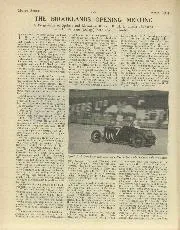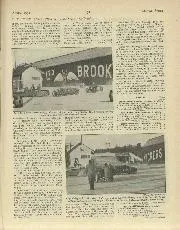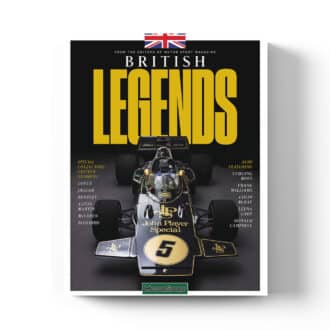

THE BROOKLANDS OPENING MEETING
THE BROOKLANDS OPENING MEETING A Programme of Sprints and Mountain Races. R. H. L. Eccles (Bugatti) and D. Bertram (Delage) both score "Doubles." r r HE frosty weather having hindered…
The 2019 aero regulations, borrowing from research done for 2021 and made with the intention of allowing the cars to run closer to each other, did Red Bull no favours.
One of the key changes was the limitation of the under-nose vanes to three per side. Previously there was no restriction. These vanes were a crucial part of Red Bull’s aero philosophy, of splitting the flow to give adequate energy to both the underfloor and the sides of the body. Getting the ratio right has arguably been the key to making a fast car ever since the 2009 regulations were put in place. You need good flow down the sides so that it exits between the inner face of the rear wheel and the diffuser wall with enough energy to draw hard on the flow coming through the diffuser, thereby accelerating that downforce-creating flow.
But those two flows originate from much the same place at the front and so have to be split there, by way of the barge boards, but also those under-nose vanes. Getting the proportions of that split right – under all the different dynamic states of the car in pitch, dive, roll and at different speeds – is crucial. Too much to the underfloor and it doesn’t get help from the draw of the bodyside flow. Too much to the bodysides and the floor gets starved. Those multiple vanes beneath the nose allowed that split to be controlled – especially important on the Red Bull, with a short wheelbase giving less distance in which to turn the air without it detaching.
The RB15 has struggled to keep that split in the correct proportion. So it’s been great into the corners, as before, but cannot keep that flow working in harmony as the pitch and roll of the car changes through the mid-corner and exit.
This has all come at a highly inconvenient time. Max Verstappen has a performance clause in his contract that could put him on the market as early as next year. With Mercedes and Ferrari seats possibly available, he needs to assess where his best prospects lie in the long term.
The aero team has been working flat out trying to compensate for the vane limitation. Coming into the French Grand Prix there were new wheels front and rear, with more spokes ostensibly for better heat dissipation. But the front wheel hubs were also different, with a complex arrangement of slots and holes creating the sort of fan effect that almost certainly plays tricks with the crucial airflow around the wheel. Blown axles are now banned, but blown wheels are not. Red Bull appeared to be controlling the airflow with this accelerated flow through the wheel. If it could make this work, it would potentially allow the flow down the bodysides to work better. Which would make it easier to get that crucial split correct.
It didn’t make a night-and-day difference at Ricard, where Verstappen qualified fourth, more than 1sec off Lewis Hamilton’s pole time. But at least the newly upgraded Honda Phase Three engine was working well – and in percentage terms the team had cut a chunk of its deficit to Mercedes compared with the similarly demanding Barcelona a month earlier. Verstappen maintained that place in the race, well distant from Hamilton, who led a Mercedes 1-2 in the least eventful race of the year. Charles Leclerc took third.

One week later the circus decamped to the Red Bull Ring in Austria. The team brought a new front wing, not drastically different visually to the old one. But it was all about switching on the effects of the wheel hubs introduced in France. The wing’s endplate wall ramped down a little more, helping to outwash more of the airflow around the tyre, meeting up with that flow coming through the new fanned wheel hubs, accelerating it all and directing it to have a narrower outwash wake, reducing the drag. The inboard ends of the elements were also subtly different, creating a stronger vortex to power the air through the barge boards. The work paid off – in Austria, at least – with a car in which Verstappen could finally have a consistency through the corner.
He qualified third, within 0.4sec of Leclerc’s pole-sitting Ferrari. Verstappen was only 0.2sec slower than Hamilton’s Mercedes – but with the proviso that the Merc was running in very compromised form with its cooling on this super-hot weekend at 660 metres of altitude. Furthermore, Hamilton would be given a three-place grid penalty for baulking Kimi Räikkönen’s Alfa in Q1. That put Verstappen on the front row – to the delight of the army of orange-clad fans.
They groaned as Verstappen bogged down at the start and the anti-stall kicked in. Into Turn One, he was eighth. He pulled one place back by out-braking team-mate Pierre Gasly into Turn Four, but flat-spotted his tyres in so doing. Yet that terrible start is what would win Verstappen this race.
With no undercut pressure from behind (the Red Bull easily distancing itself from the McLaren-led ‘Class B’ battle), Verstappen was immune to the compromised strategies of the Ferraris and Mercs ahead. The leaders each had to either try to undercut or defend up to the pit stops. Verstappen was able to keep going for an extra 10 laps or more. That put him on newer, quicker, tyres when he rejoined. Ahead of him were Sebastian Vettel, Bottas and Leclerc.
He was given permission to run the new Honda at ‘mode 11’ for the rest of the race, certain to cost engine mileage and perhaps penalties later in the season, but this was now – and there was a scent of sensation in the air. His grip advantage was such that he dispatched Vettel and Bottas without fuss. Some distance away was Leclerc, a nemesis since they were kids in karts and still looking for that first win. Leclerc had controlled his weekend beautifully, sealing pole and leading from the off. But Ferrari had kept him on a tight leash during that first stint, not seeming to realise that his main rival was Verstappen. Now came the penalty for not having let Leclerc build up a bigger cushion.
Leclerc probably didn’t need the team to alert him to Verstappen’s charge, such was the crowd reaction to the Red Bull’s gains. He upped his pace, but not enough. With four laps to go Verstappen was right with the Ferrari. He went up the inside into Turn Three and was briefly ahead to the roar of the crowd, but Leclerc cut back inside to regain the lead into Four. Another lap to gather himself and Verstappen attacked again into Three, this time even later on the brakes and ahead well before the turn-in point. Leclerc hung on around the outside knowing the run-off area provided an escape if needed. They touched, Leclerc took the run-off – and Verstappen was through for the first non-Mercedes win of the season and Honda’s first since 2006. The stewards decided against any action.
The Austria win was timely for all sorts of reasons, but Verstappen was keen to see how the car’s improved traits translated at Silverstone. While the result didn’t come close to that of Austria – he finished fifth behind team-mate Gasly after being hit into the Vale gravel by an errant Vettel just after passing him for third – the underlying trend was good. His qualifying time (behind Bottas, Hamilton and Leclerc) was only 0.2sec off pole despite throttle lag. In percentage terms, it’s the closest the car has been all season. There is a caveat: Mercedes had set up its car to protect the vulnerable left-front tyre and so lacked a little balance.
That tyre strain was in fact key to the race between the Mercedes drivers as Hamilton produced a dazzling display of speed, tyre conservation and tactical nous to beat two-stopping Bottas with just a single stop – against even the expectation of his own team. It was a brilliant display and Merc’s ninth win from 10 races – the sort of stat that could yet turn Verstappen’s head.



